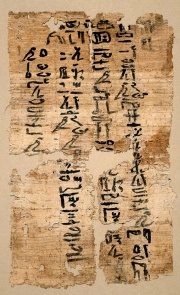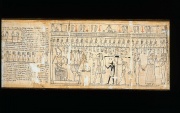Difference between revisions of "Papyrus"
(username removed) |
(username removed) |
||
| Line 11: | Line 11: | ||
== Additional Information == | == Additional Information == | ||
| − | B.Leach, J.Tait, "Papyrus" in ''Ancient Egyptian Materials and Technology'', P.Nicholson, I.Shaw (eds.), Cambridge University Press, 2000, p. 227-253. | + | ° B.Leach, J.Tait, "Papyrus" in ''Ancient Egyptian Materials and Technology'', P.Nicholson, I.Shaw (eds.), Cambridge University Press, 2000, p. 227-253. ° A. Wallert "The Reconstruction of Papyrus Manufacture: A Preliminary Investigation" ''Studies in Conservation'' 34:1-8, 1989. |
== Additional Images == | == Additional Images == | ||
| Line 23: | Line 23: | ||
== Authority == | == Authority == | ||
| − | * | + | * A.Lucas, J.R.Harris, ''Ancient Egyptian Materials and Industries'', Edward Arnold Publishers Ltd., London, 4th edition, 1962 |
| − | * ''Encyclopedia Britannica'', http://www.britannica.com Comment: "papyrus" | + | * ''Encyclopedia Britannica'', http://www.britannica.com Comment: "papyrus" Encyclopædia Britannica [Accessed October 31, 2001]. |
| − | * | + | * R. J. Gettens, G.L. Stout, ''Painting Materials, A Short Encyclopaedia'', Dover Publications, New York, 1966 |
| − | * | + | * Hermann Kuhn, ''Conservation and Restoration of Works of Art and Antiquities'', Butterworths, London, 1986 |
| − | * | + | * Matt Roberts, Don Etherington, ''Bookbinding and the Conservation of Books: a Dictionary of Descriptive Terminology'', U.S. Government Printing Office, Washington DC, 1982 |
| − | * | + | * G.S.Brady, ''Materials Handbook'', McGraw-Hill Book Co., New York, 1971 Comment: p. 573 |
* ''The American Heritage Dictionary'' or ''Encarta'', via Microsoft Bookshelf 98, Microsoft Corp., 1998 | * ''The American Heritage Dictionary'' or ''Encarta'', via Microsoft Bookshelf 98, Microsoft Corp., 1998 | ||
| Line 39: | Line 39: | ||
* Art and Architecture Thesaurus Online, http://www.getty.edu/research/tools/vocabulary/aat/, J. Paul Getty Trust, Los Angeles, 2000 | * Art and Architecture Thesaurus Online, http://www.getty.edu/research/tools/vocabulary/aat/, J. Paul Getty Trust, Los Angeles, 2000 | ||
| − | * | + | * George Savage, ''Art and Antique Restorer's Handbook'', Rockliff Publishing Corp, London, 1954 |
| − | * | + | * Book and Paper Group, ''Paper Conservation Catalog'', AIC, 1984, 1989 |
[[Category:Materials database]] | [[Category:Materials database]] | ||
Revision as of 06:26, 24 July 2013
Description
The name for both a writing material and a tall aquatic sedge plant, Cyperus papyrus, native to the Mediterranean region. The papyrus plant was used to make ancient book scrolls in Egypt as early as the 3rd millennium BCE. Its use spread to the Greeks and then to the Roman Empire. Papyrus was used in Sicily as late as the 11th century CE (Wallert 1989). The fresh water plant is cut, stripped of the rind then sliced thinly. The strips adjacent to each other to form a layer, then covered with another layer of strips placed at right angles. Two or three layers are built up, then pressed, pounded and dried to form a sturdy, pliable sheet. Papyrus can darken and discolor with age. It contains about 22-32 % lignin that degrades in the presence of moisture and light.
Synonyms and Related Terms
Egyptian paper rush; paper plant
Additional Information
° B.Leach, J.Tait, "Papyrus" in Ancient Egyptian Materials and Technology, P.Nicholson, I.Shaw (eds.), Cambridge University Press, 2000, p. 227-253. ° A. Wallert "The Reconstruction of Papyrus Manufacture: A Preliminary Investigation" Studies in Conservation 34:1-8, 1989.
Additional Images
Authority
- A.Lucas, J.R.Harris, Ancient Egyptian Materials and Industries, Edward Arnold Publishers Ltd., London, 4th edition, 1962
- Encyclopedia Britannica, http://www.britannica.com Comment: "papyrus" Encyclopædia Britannica [Accessed October 31, 2001].
- R. J. Gettens, G.L. Stout, Painting Materials, A Short Encyclopaedia, Dover Publications, New York, 1966
- Hermann Kuhn, Conservation and Restoration of Works of Art and Antiquities, Butterworths, London, 1986
- Matt Roberts, Don Etherington, Bookbinding and the Conservation of Books: a Dictionary of Descriptive Terminology, U.S. Government Printing Office, Washington DC, 1982
- G.S.Brady, Materials Handbook, McGraw-Hill Book Co., New York, 1971 Comment: p. 573
- The American Heritage Dictionary or Encarta, via Microsoft Bookshelf 98, Microsoft Corp., 1998
- Art and Architecture Thesaurus Online, http://www.getty.edu/research/tools/vocabulary/aat/, J. Paul Getty Trust, Los Angeles, 2000
- George Savage, Art and Antique Restorer's Handbook, Rockliff Publishing Corp, London, 1954
- Book and Paper Group, Paper Conservation Catalog, AIC, 1984, 1989



